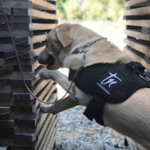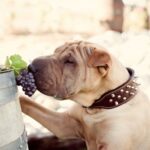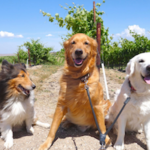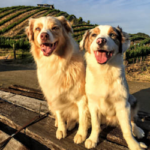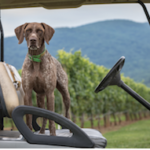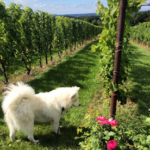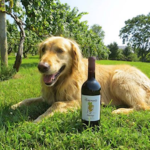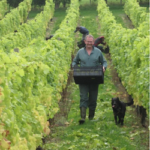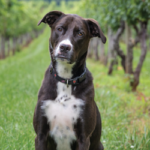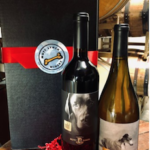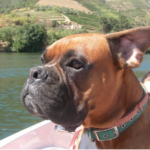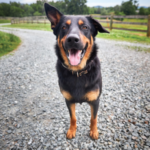The Working Dog Series: Winery Dogs
Introduction
Throughout history, since domestication (approximately 33,000 years ago), dogs have had jobs. Only later in canine evolution did some actually live inside human dwellings and become house pets as well. The non-dog owner may not be acquainted with the many breeds and their unique talents but even the well-informed dog owner may not know how the skills of our canine friends have evolved to today. As society evolves, there are new-found problems and challenges that in some cases only dogs can help us solve.
Introducing the NEW working dogs of today. In addition to the skills that are “built in” to certain breeds, we will explore the new jobs that some dogs have learned that didn’t exist years or decades ago. For example, there are dogs that can smell cancers, dogs that can detect drugs at airports, dogs that can use the magnetic fields of the earth to track and locate things, and many more fascinating talents that we are still discovering.
Winery Dogs in Focus
The vineyard dog is often as glamorized as the winemakers themselves, but they are much more than cute fuzzy pets that hang-out in the tasting room greeting visitors and keeping children occupied while their parents sample the vintages. Most of these animals are typically blue-collar farm dogs: loyal to their tasks and their humans, the bane of foraging creatures, and the beloved heroes of the vines.
Dogs Can Detect Vine Diseases, Invasive Bugs and Contaminants
With their powerful noses, dogs can sniff out pests and contaminants to protect the quality of vines, barrels and wine around the world.
- Chemical compounds like TCA (2,4,6-Trichloroanisole) ruin wine by tainting corks, wooden barrels and packaging. Labrador retrievers work with the team at a Chile-based cooperage to help detect TCA in the wood used to make handcrafted wine barrels. Compared to technology that can detect the contaminants in the air, the dogs can pinpoint exactly which barrel, pallet or hose is contaminated.
Sniffer dog Happy Habanero Ehime, Kona, Kahlua Ruby & Brix - In a relatively new specialized school, Bergin University of Canine Studies at Santa Rosa, California trains dogs, mostly labrador retrievers, to sniff out vine mealybugs in vineyards. While the pest is not rampant in California vineyards, it is an ongoing winegrower issue that requires continued attention. The golden retrievers can detect the female mealybug pheromone. Early detection of the bug allows the grower to treat or remove a vine or two, alleviating any broad use of pesticides, which is in keeping with many vineyards wish to use sustainable measures. The school states that “Labs have great noses, they have incredible sensory abilities compared to other dogs, and are such good learners. They have a very high drive to work and to please (humans), they are always looking to do something. They have a very high work ethic.”
-
Researchers around the world have been training dogs to sniff other vine vexers, such as the devastating disease phylloxera.
They Keep Vine-Munchers and Vermin at Bay
- Vineyards, especially at certain times of the growing season, fill the air with wonderful smells that easily attract all sorts of creatures. Dogs of many different kinds have been used to protect the vineyard crops. Australian Shepherds, Corgies, various retrievers, Shetland Sheepdogs and many others including mixed breeds that you may not expect to see working in a vineyard.
- Chasing raccoons, squirrels, gophers, turkeys, deer and various winged invaders (e.g.,birds & geese) keep these seemingly tireless dogs working hard to protect the harvest.
They Watch the Flock
-
- Many vineyards use flocks of sheep or alpaca to graze the fields and fertilize the vines in winter eliminating the need for weed killers. Often larger dogs such as Kuvasz or Great Pyrenees are added to help keep away more aggressive predators, and protect the animals from wildlife like wild pigs and mountain lions. When the vineyard workers see tracks, they quickly call in the dogs. The vineyard owners explain that they are “SIP (Sustainability in Practice) certified as a result of these techniques, and our dogs are an integral part of this process. They definitely work for a living and live to work. A working ranch and winery without working dogs is not working on all cylinders, in our opinion.”
-
Boone Sitka Tug Vineyard in Action Millie
They Are Great at Boosting Sales
-
-
All dog lovers know what charmers their pets can be. Throw them into the mix with a sunny, vine-combed landscape and award-winning wines, and you have a winning combination. Often visitors say “Yep, we’d buy anything this dog is selling – especially wine.
- These dogs know very well how to “work the crowd” and many even have their own wine labels that visitors love and jokingly request an autograph.
Corgy Canine Labels Charlotte & Matilda Mungo Beau
-
Each of the wineries ‘working canines’ bring their own personality and charm to the vineyard. Some have multiple jobs, some have very specific tasks but all of them bring an enthusiasm and love for what they do. Whatever their job, whether greeting visitors or keeping predators away, they take their jobs seriously. And because they have become such an integral part of the business of running a winery, their humans ask themselves, almost daily, “How did we do this without them?”
“In vino canibus veritas“

